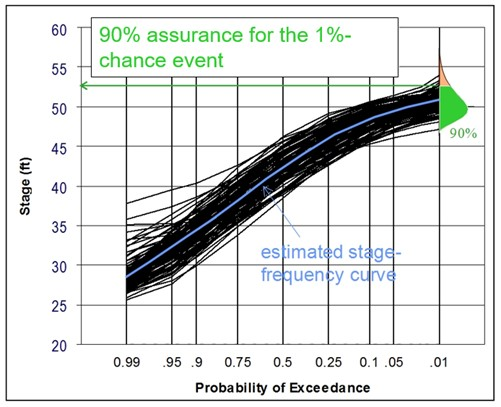Available Performance and Economic Metrics
The performance and economic metrics computable with the Performance Metrics Plugin are listed below.
Expected Annual Damage (EAD)
Expected Annual Damage (EAD) is an economic metric that is the average or mean of all annual damage determined from a Monte Carlo (a numerical integration approach) analysis of variables that contribute to EAD, along with those variables' associated uncertainties. HEC-WAT can compute both EAD and the uncertainty about EAD, as shown in Figure 19.1. An HEC-FIA model is required in the FRA compute for EAD to be computed.
HEC-WAT results for EAD provide the user with a general idea of how the EAD estimates are probabilistically distributed and easily characterize some global aspects of the distribution (skew, data gaps, etc.). During an FRA simulation, the consequence model alternative (FIA) can produce damage for each simulated flood event. HEC-WAT can then collect these damage results and calculate an average value per life cycle for each simulation which is analogous to an EAD estimate. All of these EAD estimates can then be assigned an equal probability. Finally, HEC-WAT can create a probability density function of EAD with uncertainty.
Annual Exceedance Probability (AEP)
Annual Exceedance Probability (AEP) is the probability that a specific target stage at a location of interest will be exceeded in a given year, based on the full range of possible flows. Within the HEC-WAT Performance Metrics tool the user can select a common computation point (CCP) location and, for each location the user can specify a target stage. This means that the target stage is per location, and the locations must be CCPs. For each selected CCP, the user will be able to 
EAD with Uncertainty Plot – PDF (probability distribution function)
select an input DSS time series record from any model alternative. An example, is an AEP of stage at a CCP, is generated by an RAS model alternative. It should be noted that stage information from HEC-RAS storage areas is not currently available for AEP evaluation. AEP is used in the calculation of Assurance and Long Term Exceedance Probability (LTEP).
Assurance
The performance metric Assurance (also known as Conditional Non-Exceedance Probability, CNP), is the probability that a specific target (e.g., the top of a levee) will not be exceeded, given the occurrence of a specific flood event. This is illustrated in Figure 19.2, which shows that a stage of 53 feet is not exceeded for 90 percent of the stages modeled for the 1 percent ACE (Annual Chance Exceedance). To compute Assurance, create a performance metrics alternative and define an AEP location (Section 19.1.4). When AEP is calculated, assurance will also be automatically calculated for six exceedance probabilities: 10%, 4%, 2%, 1%, 0.5% and 0.2%.
Long Term Exceedance Probability (LTEP)
Long Term Exceedance Probability (LTEP) is a performance metric that is the probability that one or more flood events will occur within a specified time period or the likelihood that the target stage will be exceeded in a specified time period. LTEP results are currently available for three time periods in HEC-WAT: 10-, 30- and 50-years. The calculations use the binomial distribution and the computed AEP (EM 1110-2-1415).
Assurance